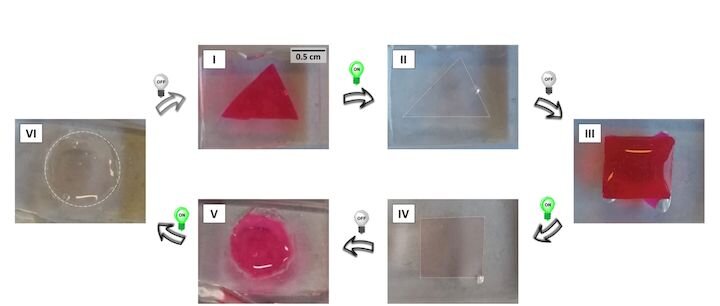![Example of a reversible light-stabilized material lifecycle [Source: ACS]](https://fabbaloo.com/wp-content/uploads/2020/05/image-asset_img_5eb08fdcb7d7b.jpg) Example of a reversible light-stabilized material lifecycle [Source: ACS]
Example of a reversible light-stabilized material lifecycle [Source: ACS]
Researchers have developed a highly unusual polymer that has the incredible ability to soften when placed in darkness.
Light-Stabilized Dynamic Materials
The researchers composed a complex polymer material that can repeatedly change its stiffness when exposed to (or taken from) light exposure. They explain:
“The light-responsive adaptation of polymer materials typically requires different wavelengths or additional heat to induce reversible covalent bond formation and dissociation. Here, we bypass the use of invasive triggers by introducing light-stabilized dynamic materials that can undergo a repeatable change in topology from a covalently cross-linked material into a liquid polymer formulation by switching one visible light source on-and-off without the need for any additional triggers.
Specifically, we exploit the photo-Diels–Alder reaction of triazolinediones with naphthalenes as a dynamic covalent cross-linking platform that enables green light-induced network formation, while the cross-linked material collapses through spontaneous cycloreversion upon standing in the dark at ambient temperature. Importantly, the covalent cross-links remain stabilized for as long as visible light is present, thereby retaining the material’s structural integrity.”
And:
“This enables their potential use in an array of light-directed applications whereby network properties such as stiffness can be tuned by the mildest trigger of all: darkness.”
This is a very unusual property that I haven’t seen previously. Note that this is not — at least at the moment — a viable 3D printing material. The researchers were merely developing a polymer.
![Measurements of a light-stabilized polymer [Source: ACS]](https://fabbaloo.com/wp-content/uploads/2020/05/image-asset_img_5eb08fdd05d9b.jpg)
However, it may be possible to eventually produce a 3D printable material that exhibits the same properties: softening in the dark.
What Could You 3D Print With Light-Stabilized Dynamic Materials?
Let’s imagine what kinds of designs might be possible using this material. Could we design a sensor that activates when darkness occurs? Certainly! What about a sensor that activates when light is detected, the opposite? Yes, again.
The really interesting part is that this effect is reversible. Thus you could design a sensor that triggers, and then, given some ingenious geometry, resets itself for subsequent activity.
It’s fun to imagine what might be possible, but there’s a bigger thing going on here. That is the fact that there are a near-infinite number of possible materials, as researchers are discovering them all the time. Some will become available as materials for 3D printing in time, and their presence could change how certain types of mechanisms are designed.
Remember, 3D printing does not only allow for the creation of impossible object geometries, but also allows for the inclusion of highly unusual materials, too.
Via ACS (Hat tip to Benjamin)

